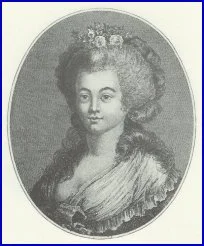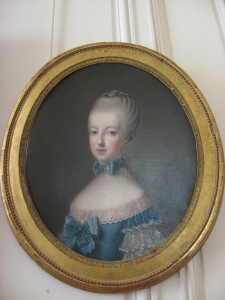Starting with this post, I am going to be writing about the endlessly fascinating Affair of the Diamond Necklace. In this issue: the Comtesse de La Motte, the orchestrator of a diamond theft that rocked the world.
This is all prompted by the historical novel I’m working on. I’m 40k into the story (give or take 401 words; or, rather, take 401 words because it’s at exactly 39,599). Obviously, I’ve gotten a hell of a lot done already, and I’m pretty pleased with what I have. I will have to go back and do a little bit of cleaning up, I think, just to make sure I haven’t inadvertently given the wrong impression about this, that, or the other thing. The story is being set up rather like a thriller or a mystery, though the revelation (which I just wrote) comes around halfway through the story, not at the end. The denouement (or at least the aftermath of poor Nicole’s realization) is going to be much longer. Because, after all, it’s about her, not about the story.
The Characters #1: Jeanne de La Motte-Valois de St Remy (July 1756 – August 1791)

Jeanne de Valois de St Remy was born in the provinces, near the town of Bar-Sur-Aube, France. Her family were impoverished nobility, living in the ramshackle Chateau de Fontette. One of her ancestors, Henri de Saint-Remy, was born in 1557, the illegitimate son of Henri II of France. His descendants were given the surname “Saint-Remy” and this Henri was made Baron of Fontette. Several generations later, the family was in dire financial straits. They had kept themselves alive through a tradition of military service, but Jeanne’s father did not carry on this tradition. He married one of the maids as the family fortunes sank even lower. Jeanne had an older brother, a younger sister who died as a young child, and a sister who was near her age. Her family ended up walking to Paris to try to make their way with only a paper outlining their pedigree. The father died, the mother abandoned her children, and Jeanne and her brother were forced to beg.
According to Jeanne, she carried her little sister on her back and went to the road to Passy, where she met the Marquise de Boulainvilliers, who took her in. She was sent to school (and didn’t like it), worked for increasingly lowly couturiers (and didn’t like it), and was briefly in a convent (and didn’t like it). She returned to Bar-sur-Aube, running away from the convent. There she was supported by the Beugnot family. After what appears to have been what is called a “shotgun wedding” in common parlance, she went to Paris with her husband (Nicolas Marc-Antoine de La Motte), looking to make her fortune by importuning the queen with her sad story. She expected that, as the last (though illegitimate) living Valois, she would be given some support. She was actually given a fairly generous annuity, considering how distant her relation was to the king. She was also to be known as Mademoiselle de Valois, her brother was given the title Baron de Valois, and her sister was to be called Mademoiselle de St Remy.
Her publicity stunts at Versailles grew increasingly desperate. She fainted in front of Madame Elisabeth, King Louis XVI’s sister, and even managed to get into the good graces of Madame Elisabeth and the Comtesse d’Artois, the King’s sister-in-law. Then there was some little scandal involving Jeanne and the Comte d’Artois, her patroness’s husband. She fell out of favor. She went to one minister and refused to leave until she was listened to. This produced a slight increase in her pension. Still, she was in troubled waters.
This is where her story gets interesting. Jeanne, now calling herself a countess, had begun to convince people in about 1783 to 1784 that she was a close friend to the queen. She put around the story that she and the queen were on intimate terms. The pandering of influence was big business in a time and place where all good things flowed from the king and, especially there and then, from queen Marie-Antoinette. Jeanne roped in a Cardinal and Prince of the blood, a man named Prince Louis de Rohan. He had alienated the queen when she was still Dauphine (queen in waiting), and wanted to get back into her favor. Jeanne took advantage of him, bilking him for one hundred twenty thousand francs, a vast sum. She did it by having her “personal secretary” Retaux de Villette forge letters from the queen. The “queen” requested loans because she was more than usually hard up–because, of course, the queen of France typically had such troubles (or not). In any case, Jeanne apparently pocketed the money and showed sudden signs of affluence. She returned briefly to Bar-sur-Aube, lording it over the locals.
Then this all got very interesting. Continue reading →






















